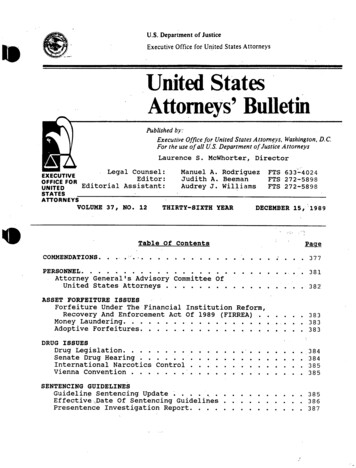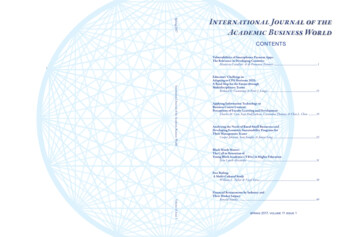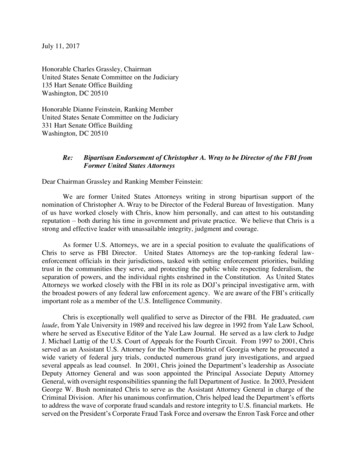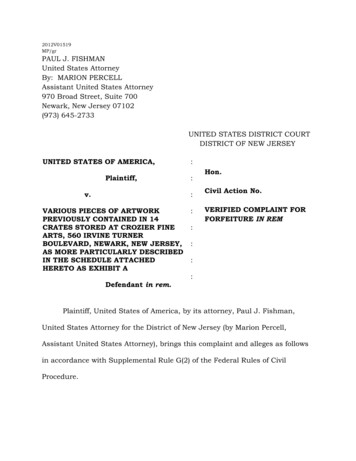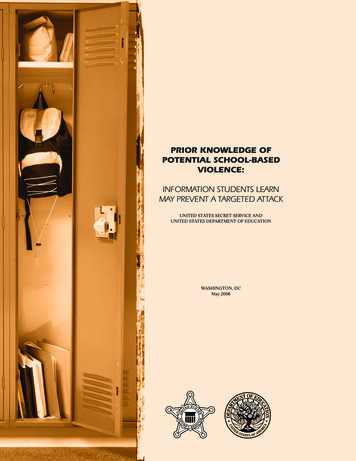
Transcription
PRIOR KNOWLEDGE OFPOTENTIAL SCHOOL-BASEDVIOLENCE:INFORMATION STUDENTS LEARNMAY PREVENT A TARGETED ATTACKUNITED STATES SECRET SERVICE ANDUNITED STATES DEPARTMENT OF EDUCATIONWASHINGTON, DCMay 2008
1Prior Knowledge of Potential School-Based Violence:Information students learn may prevent a targeted attackUNITED STATES SECRET SERVICEANDUNITED STATES DEPARTMENT OF EDUCATIONbyWilliam S. Pollack, Ph.D.Director, National Violence Prevention and Study CenterDirector, Centers for Men and Young Men, McLean HospitalAssistant Clinical Professor of PsychologyDepartment of Psychiatry, Harvard Medical SchoolWilliam ModzeleskiAssociate Assistant Deputy SecretaryOffice of Safe and Drug-Free SchoolsU. S. Department of EducationGeorgeann RooneyThreat Assessment SpecialistNational Threat Assessment CenterU. S. Secret Service
2AcknowledgmentsAs much as this work was a collaborative effort among agencies and institutions, it was a groupeffort by many dedicated individuals as well. The authors would like to express their gratitude toseveral individuals whose support and insight were invaluable in conceptualizing the study,analyzing data, and shaping the final report. These individuals, in alphabetical order, are: LinaAlathari, Carol Brown, Bruce Cohen, Karen Damato, Matthew Doherty, Robert Fein, ShervertFrazier, Tara Hill, Michelle Keeney, Arthur Kelly, Susan Keverline, Philip Levendusky, TraceyMullins, Peter Paskevich, Marisa Randazzo, Scott Rauch, Deborah Rudy, Sara Strizzi, BryanVossekuil, and Megan Williams.
3Prior Knowledge of Potential School-Based Violence:Information students learn may prevent a targeted attack1In the wake of several high-profile shootings at schools in the United States, most notably theshootings that occurred at Columbine High School on April 20, 1999, the United States SecretService (Secret Service) and the United States Department of Education (ED) embarked on acollaborative endeavor to study incidents of planned (or targeted) violence in our nation’sschools. Initiated in 1999, the study, termed the Safe School Initiative (SSI), examined severalissues, most notably whether past school-based attacks were planned, and what could be done toprevent future attacks.The SSI employed a method similar to an earlier Secret Service study, the Exceptional CaseStudy Project (ECSP), that examined targeted attacks on public officials and public figures (Fein& Vossekuil, 1999). In the ECSP the Secret Service coined the term targeted violence anddefined it as any incident of violence where a known or knowable attacker selects a particulartarget prior to the violent attack (Fein, Vossekuil, & Holden, 1995). As with the ECSP, the SSIemployed an operational focus to assist those involved with school safety to improve preventionefforts by increasing knowledge of targeted violence in schools. By studying past incidents oftargeted violence in schools, the Secret Service and ED examined whether pre-attack behaviorsof perpetrators could be identified to prevent future attacks.The SSI identified specific incidents of targeted school violence and analyzed the attackers’behavioral pathways, from the initial idea of the attacks to the violent conclusions. Thisinvolved an in-depth study of 37 incidents of targeted school violence involving 41 perpetrators,which took place in the United States from January 1974 through May 2000. A full report of thefindings as well as the significant implications for both practical application and furtherinvestigation may be found in two jointly published Secret Service/ED reports: The Final Reportand Findings of the Safe School Initiative: Implications for the Prevention of School Attacks inthe United States (Vossekuil, Fein, Reddy, Borum, & Modzeleski, 2002) and Threat Assessmentin Schools: A Guide to Managing Threatening Situations and to Creating Safe School Climates(Fein et al., 2002). The reports focused on 10 key findings from the SSI: 1Incidents of targeted violence at schools rarely were sudden impulsive acts.Most attackers did not threaten their targets directly prior to advancing the attack.There was no useful or accurate “profile” of students who engaged in targeted schoolviolence.Most attackers had difficulty coping with significant losses or personal failures.Moreover many had considered or attempted suicide.Many attackers felt bullied, persecuted or injured by others prior to the attack.Most attackers had access to and had used weapons prior to the attack.Despite prompt law enforcement responses, most shooting incidents were stopped bymeans other than law enforcement interventions.The study is on file with the McLean Hospital Institutional Review Board (IRB) under the title “A Systematic PilotStudy of Student Responses to Prior Knowledge of Potential School-Based Violence: What can we learn about lifesustaining prevention?”
4 In many cases, other students were involved in some capacity.Most attackers engaged in some behavior prior to the incident that caused others concernor indicated a need for help.Prior to the incidents, other people knew about the attacker’s idea and/or plan to attack.While each of these findings is important and may be useful in detecting and preventing futureattacks, the final two findings in particular highlight further areas of inquiry. First, theperpetrators exhibited concerning behavior prior to the attack in 93% of the incidents. Thissuggests that attacks might have been avoided with proper observation techniques and more opensharing of information. Second, and more significant, at least one other person had some type ofknowledge of the attacker’s plan in 81% of the incidents and more than one person had suchknowledge in 59% of the incidents. Of those individuals who had prior knowledge, 93% werepeers of the perpetrators – friends, schoolmates, or siblings (Vossekuil et al., 2002).Study PurposeThe SSI findings highlight that in most targeted school-based attacks, individuals, referred to asbystanders in this report, had some type of advanced knowledge about planned school violence.Despite this advanced knowledge, the attacks still occurred. This study aimed to further theprevention of targeted school-based attacks by exploring how students with prior knowledge ofattacks made decisions regarding what steps, if any, to take after learning the information.2 Thestudy sought to identify what might be done to encourage more students to share informationthey learn about potential targeted school-based violence with one or more adults.Among the topics covered in semi-structured interviews with participants were the following keyquestions: What information was known by the bystander in advance of the attack? What relationship did the bystander have to the perpetrator(s)? Did the bystander share the information he or she learned of the planned violence withothers? Was the bystander alone in his or her knowledge of the planned attack or was therediscussion with other bystanders? If there was discussion among several bystanders, wasthere an agreement among them as to whether to report the information? How much did personal characteristics of the bystander as compared with issues relatedto the school climate influence the bystander’s decision regarding whether to comeforward with the information? What were the relationships and levels of interpersonal connections between thebystander and responsible adults? In retrospect, how did the bystander feel about his or her decision regarding whether totake action? What advice would the bystander give others?2This study was conducted in partnership with McLean Hospital, a teaching affiliate of Harvard Medical School,and underwent human participants review through its IRB. The principal investigator was William S. Pollack.
5MethodStudy ParticipantsInitially, potential participants were identified in reference to two groups. One group includedthose students who had prior knowledge of planned school violence and were believed to haveshared that knowledge to avert the planned attack. Participants in this group were identifiedthrough online searches of publicly available material, as well as through outreach to lawenforcement and school personnel, for information about school shootings that were averted andindividuals who had prior knowledge of the threatened targeted school violence. The secondgroup included those students who had prior knowledge of planned targeted school violence andwho attended a school where a shooting occurred. Participants in this group were drawn fromthe 37 cases originally studied in the SSI. Participants who indicated that they had some type ofprior knowledge were identified from a review of media reports, law enforcement records, andcourt records contained in the SSI case files. In all, 198 bystanders were identified from the fileswith the number of bystanders identified per incident ranging from 0 to 28. Individuals whoactively planned or encouraged the attack were omitted from the study.Once potential participants were identified, researchers determined whether each participant metthe study’s inclusion criteria. Initially, participants were to be selected based on considerationsrelated to the recency of the case, the participant’s level of knowledge regarding the plannedschool attack, and the participant’s relationship with the perpetrator of the attack. However,when recruitment for the study proved difficult more emphasis was placed on the participant’saccessibility and willingness to be interviewed.Researchers contacted 29 individuals who met the study’s inclusion criteria. Fourteen of theindividuals contacted either refused participation in the study or did not complete the informedconsent process in spite of several outreach attempts. Thus, the final study participants consistedof 15 individuals, six of whom had prior knowledge of a potential threat and attended a school atwhich a school shooting was averted, and nine of whom had prior knowledge of a potentialthreat and attended a school at which a school shooting occurred. The six participants in the firstgroup were drawn from four independent incidents in which a school attack was averted (twoparticipants each from two incidents and one participant each from two separate incidents). Thenine participants in the second group also were drawn from four independent incidents in whicha shooting occurred at school (four participants from one incident, three participants fromanother incident, and one participant each from two separate incidents). In total, the participantsrepresented eight school locations. At the time of the study, the participants ranged in age from13 to 30 years.ProcedureA member of the research team telephoned each participant (or legal guardian if the participantwas a minor) and described the nature of the study and its benefits and risks. If the participantagreed, consent forms were mailed to the participant for review. The consent forms, approvedby the McLean Hospital Institutional Review Board (IRB), included versions for adults andminors aged 13 to 17 years. The forms addressed two aspects of consent: consent to participatein the study interview and consent to have the study interview videotaped. Fourteen participants
6consented to videotaping of their study interviews. Once the signed consent forms werereturned, a confidential location was agreed upon for the interview.Study data were gathered via review of SSI case files, public sources, and a semi-structuredinterview with each participant (n 15). The data were analyzed by researcher reviews of thetaped interviews, first independently and later in conference. Case vignettes, included as anAppendix, were developed from the subject interviews.In the process of reviewing the data, the researchers observed similarities as well as somedifferences between the group of students who had prior knowledge of planned targeted schoolviolence and came forward with the information to avert the violence, and the group of studentswho had such prior knowledge but attended a school at which violence occurred. Due to theoverlapping data and an emerging continuum between these two groups, which originally hadbeen expected to be more distinct in nature, the groups were collapsed into one group forpurposes of analysis.FindingsSix key findings were identified. Given the small sample size and the exploratory nature of thestudy, generalization from these findings may be limited.1. The relationships between the bystanders and the attackers, as well as when and howthe bystanders came upon information about the planned attacks, varied.From the original SSI case files, there was information available about the relationship between119 of the bystanders and the attackers. Of those, 34% were friends with the attacker, 29% wereacquaintances/co-workers/schoolmates, 6% were family members, and in 31% of the cases therelationship was of another type or unknown. Eighty-two percent of the bystanders receivedinformation directly from the attacker and 13% were told secondhand.3 Details about when thebystander learned the information were available in 91 of the cases. A majority of thoseindividuals received the information more than a day before the attack. Fifty-nine percent weretold days or weeks in advance, 22% were told months or years prior, and 19% were told a fewhours or less before the attack.2. Bystanders shared information related to a threat along a continuum that ranged frombystanders who took no action to those who actively conveyed the information.Participants displayed a range in their actions and willingness to come forward. A continuumemerged between bystanders who took no action and those bystanders who were proactive inconveying information related to the threat to others. For instance, while some came forwardwithout external prompting and were entirely forthcoming, others revealed the information theyknew only after repeated prodding from adults, including school safety officials. In addition,some bystanders did not share their information with anyone or attempt to come forward, whileothers discussed the information with, or sought the advice of, peers and adults. Informationfrom the SSI case files indicated that only 4% of the individuals with prior knowledge attemptedto dissuade the attacker from violence.3It was unknown how the remaining 5% of the bystanders became aware of the potential threat.
73. School climate affected whether bystanders came forward with information related tothe threats.Some bystanders reported that the school climate influenced their decisions to share informationwith the school staff regarding the threats. Bystanders who came forward with informationcommented that they were influenced by positive relations with one or more adults, teachers, orstaff, and/or a feeling within the school that the information would be taken seriously andaddressed appropriately. Similarly, students who displayed a reluctance to come forwardindicated that they anticipated a negative response from the school had they shared information. One student who knew of a weapon on school property was reluctant to come forwardbecause he expected a negative reaction: “When you say something, you get in trouble orinterrogated by teachers.”4. Some bystanders disbelieved that the attacks would occur and thus did not report them.A number of bystanders reported not disclosing information related to the threat to a responsibleadult because they did not believe the event would ever occur. Several factors contributed to thisbelief, to include: The student made the threat or voiced the plan repeatedly and over a long period of time,had been engaged in what might be considered attention-seeking behaviors, and hadmade peculiar comments. The described threat seemed unbelievable because it was so extreme. In one case, abystander who had overheard some of the conspirators discussing their plans in greatdetail “didn’t think anything of it . . . [didn’t] think they would really do it” and thereforethe bystander did not tell anyone. The student’s tone when making the threat did not seem serious or it was thought he wasjoking. For instance, bystanders made comments such as “he kept eating his pizza whilediscussing the event” and “he’d say it violently but then laugh about it.” The threats or statements were overt, repetitive, and/or clearly overheard by schoolpersonnel. This led the students to mistakenly believe that the threateners (and thereforethe threats) were not serious.5. Bystanders often misjudged the likelihood and immediacy of the planned attack.Bystanders reported that often they did not come forward with information related to thepotential attack because they felt they had more time to decide on an appropriate action.Whether the potential attacker shared specific or vague information with the bystander was not adeterminant of the bystander’s assessment of the likelihood of an attack or its imminence.6. In some situations, parents and parental figures influenced whether the bystanderreported the information related to the potential attack to school staff or other adults inpositions of authority.Bystanders were questioned regarding the influence parents and other adults in their lives mayhave had on their decision to share information related to the potential attack. For example, onebystander felt comfortable sharing her concerns with other adults because her parents reassuredher it was the correct thing to do. In contrast, another bystander consulted a parent figure in hislife and was advised to “mind his own business.” The bystander did not share informationrelated to the potential attack, and the following day a shooting occurred at his school.
8ImplicationsAlthough the generalizability of this study’s findings is limited due to the exploratory nature ofthe study and the small number of participants, several implications were derived from a reviewof its data and findings. These implications may impact whether a shooting at a school isprevented by encouraging students to come forward when they learn of an event that may causeharm to themselves, other students, or faculty. Further, these implications may help faculty,staff, and other adults take appropriate action when they become aware of a threatening situation.1. Schools should ensure a climate in which students feel comfortable sharing informationthey have regarding a potentially threatening situation with a responsible adult.One factor that contributed to a bystander’s decision to share knowledge of planned schoolviolence was the student’s positive emotional connection to the school and to its staff (see alsoFein et al., 2002). Bystanders who did not share information related to the planned attackreported no connection to the school or a negative perception of the school climate. They alsoexpressed discomfort speaking to anyone, or believed that if they did speak to someone theyeither would not be believed or would get into trouble. Further, bystanders were reluctant tocome forward if they felt that school officials would not keep the source of the informationconfidential, which would open the bystander to potential ridicule and retribution.Conversely, in those instances where bystanders with information about a possible attack felt apositive emotional connection with the school or with someone on the staff, they werecomfortable coming forward and reporting what they knew. If the bystanders knew they wouldbe believed and the information they provided would be protected, they were more likely tocome forward with that information.Developing meaningful social and emotional connections with students and creating a climate ofmutual respect are essential to keeping schools safe. Such a climate encourages all students withinformation about threats against the school or its students to share the information with aresponsible adult. Students in this study felt connected to the school when they believedsomeone in the school knew them and cared for them. Schools demonstrate their commitmentsto such climates by promoting social and emotional connections between students, staff, andteachers in everyday interactions and activities. Simple and genuine measures, such as regularlygreeting students, talking to students, and addressing students by name, help to make studentsfeel connected and part of the school.Law enforcement officers and educators need to convey clearly to students that merely reportinginformation about potential threats will not subject the student to negative consequences and/orliability. In this study, many bystanders feared negative consequences would result if they wereto bring information forward. Schools and law enforcement need to counter this negativepreconception by emphasizing the value of the information that the students may hold andreassuring them that sharing will not cause harm. Because attackers sometimes communicatevague information prior to an attack, a student may be wary of overreacting and getting someonein trouble. It should be explained to students that any reported information or threats will beinvestigated and appropriate action will be taken.
9Creating a school climate in which students believe the school staff wants to hear from themabout threats or possible attacks is critical to ensuring that students come forward. Studentsshould be encouraged to come forward regardless of the amount of information they have, andschool staff should convey to the students that if they do share information about potential schoolviolence they will be supported. If students do not feel that they will be treated with respect andlistened to in a non-judgmental manner, or that the information will not be protected, they willnot come forward and the school will lose an opportunity to intervene in a possible attack, aswell as assist a troubled student.2. School districts are encouraged to develop policies that address the many aspects ofreporting a threat.While many schools have policies that address threatening behavior, these policies do not alwaysattend to all aspects of reporting threats, such as what procedure a student should follow inreporting a threat and what the school’s role is when such information is received. Schoolpolicies should: Encourage students, staff, faculty, parents, and others to report all apparent threats orthreatening or disturbing behaviors. Provide several options for the reporting of threats, including reporting anonymouslyif necessary. Ensure that all those who report a threat or threatening situation will be treated withrespect and that the information they provide will be closely guarded. Emphasize that the school will take appropriate action on all reports and will, withinthe confines of privacy laws, provide feedback to the reporting student that theinformation was received, and that appropriate action was taken. Articulate what types of student information and knowledge can be shared, withwhom it can be shared, and under what conditions it can be shared. Be clear as to who is responsible for acting on information received regarding threats. Where the law permits, include law enforcement and mental health officials in thereview process. Track threats over time so that the information collected regarding threats can be usedin the decision-making process.To prevent crime and violence effectively and intercede when necessary, it would be helpful forschools to know what types of criminal acts occur and the frequency of those acts. While manyschool districts have some mechanisms to track incidents that occur in schools, few of them trackthreats made against other students or the school (especially if the event did not result in officiallaw enforcement intervention). The result of this failure to collect and maintain recordsregarding threats is that very little is known about the extent or nature of the problem. Collectingmore data about threats will permit law enforcement officials and educators to learn more aboutwhat students or groups of students have previously engaged in these behaviors, the manner inwhich they threatened others, the actions taken by the school and law enforcement in response,and the outcome. Analysis of this information can lead to the development of a more effectivetargeted violence prevention strategy.
103. Teachers, administrators, and other faculty should be trained on how to properlyrespond to students who provide them with information about a threatening or disturbingsituation, as well as how to deal with actual threats.Students talk among themselves in lunchrooms, hallways, and classrooms about a wide varietyof topics, including inappropriate behaviors (such as bullying, harassment, and name calling) andcriminal activities (such as drug sales, possession of weapons, and threats or plots against otherstudents or the school). Staff and faculty may hear this information but sometimes discount it astypical youthful talk that does not warrant concern. However, staff and faculty would be advisedto take these conversations seriously and investigate further when the situation suggests suchaction.Schools are encouraged to train their faculty and staff to listen to what students are saying and, ifthey hear information about a potentially dangerous act, report it to the designated authority orcommittee within the school so that an inquiry may be initiated.ConclusionThis examination into why some students who knew of planned school attacks came forward andreported what they knew, while others did not, is meant to be an exploratory pilot study.Although the number of participants was expected to be relatively small, it was not anticipatedthat recruiting study participants would be as difficult. The low number of participants isattributable to a variety of factors, to include the length of time since some of the incidentsoccurred (e.g. some cases occurred 20 to 30 years ago) and that some bystanders were reluctantto speak of their experiences. Despite the relatively small sample size, the information gainedfrom this pilot study provides some insight for those involved with the prevention of schoolviolence. Additional research that builds upon the findings of this pilot study should beconducted so that additional barriers to reporting information may be identified and overcome.The data gathered as part of this study support several of the findings of the SSI. For example,many bystanders did not assess threats of violence made by other students as serious becausethey did not believe the person posed a real danger. The SSI recognized that a single individual,whether a student or adult, is often not equipped to adequately assess if a particular person posesa threat of targeted violence. The SSI recommended the creation of school threat assessmentteams to examine all threats to make an initial determination as to whether the threat is valid.This initial review would then be followed by a law enforcement-led investigation. A teamapproach would allow students to share information related to threats with adults in the schooland allow a more formal assessment as to whether the student(s) posed a danger.Further, the SSI found that while what a person said was an important part of any inquiry orinvestigation, even more important was an examination of that person’s behavior. The SSIrevealed that some shooters made inappropriate words or statements over a long period of time,resulting in their statements being disregarded as idle chatter. While words alone are not alwaysindicative of a potential attack, when viewed in the context of one’s behavior they provideinsight into one’s potential or probable actions.
11This study also highlights the importance of a school climate where adults encourage students tocome forward with information about threats and other concerning behavior, without fearingpunishment, ridicule, or not being taken seriously. All communities should develop schoolpolicies and practices to ensure students come forward when they have information about athreat or possible attack.
12Appendix: Case StudiesIn one interview, the bystander noted that the incident at his school occurred before the “wake-upcall” of the shooting at Columbine High School. In retrospect, he described being concernedwhen, prior to the shooting, the shooter aimed a gun at him in response to an action by thebystander. Also, the bystander spoke to the shooter the day before the incident and he recalledthat something about the conversation concerned him enough that he sought the advice of atrusted adult. After some questioning, the adult advised the bystander that he did not need to tellanyone about his concerns. The bystander accepted the advice and the following day his friendcarried out a shooting at the school resulting in the deaths of some of his peers.In addition to accepting the adult’s advice to not share his concerns, the bystander shared twoadditional reasons he did not share the information with others. First, he said it was “hard tobelieve [a school shooting] could happen” in his own community. Although the bystanderrecalled that he did not take the possibility of an actual shooting seriously, he mentioned that he,along with several friends and the shooter, discussed how the techniques used to carry out arecent school shooting that was widely covered in the media, could have been improved. Sincethe bystander felt, from his own perspective, that he was only engaging in fanciful teenagebravado (“kidding around”), he assumed all of his friends also were engaging in the same jokingbehavior, including the soon-to-be attacker. Second, some reluctance was clearly related to hislack of a positive connection to anyone in a position of authority in his own school. He said hefound adults at the school “too judgmental.”The bystander’s advice to other students, now younger than he, is: “Don’t take [such threats orjokes about potential violence] lightly. Come to .
shootings that occurred at Columbine High School on April 20, 1999, the United States Secret Service (Secret Service) and the United States Department of Education (ED) embarked on a collaborative endeavor to study incidents of planned (or targeted) violence in our nation's schools.





